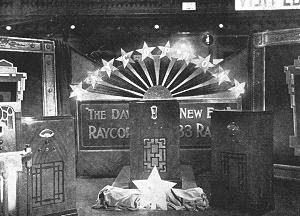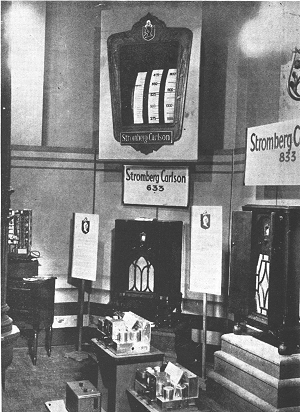The Radio Exhibition Of 1933
From "Radio Monthly", April 1933
THE public, the trade, the broadcasters - in fact, anybody who is at all interested in the development of radio - will be glad that this year's Electrical and Radio Exhibition is surpassing all expectations. All previous records have been smashed, and hardened officials themselves are amazed at the extraordinary public response to this wonderful Show. On all sides we hear of record crowds, and much more pronounced interest in everything radio, than there has been in the past.

three worthy sets worthily shown on a stand beautiful for its dignity and simplicity.
On the opening day of the 1932 Exhibition, 1600 people attended; this year 3200, or exactly double the number of last year, were in attendance. On the second day of the Show. 4666 people paid for admittance, as against 2568 the previous year, which figure was regarded as wonderfully good at that time.
Quite aside from the excellent handling of the publicity on this occasion, it is more than evident that, as each year advances, radio is getting a firmer grip on the imagination of the people, and the standard of programmes to-day is infinitely higher than it was even a few months ago. Whatever we may think about the present system of license fee distribution, it is beyond question that the Australian Broadcasting Commission, through its National stations, has created a far greater public appeal than formerly.

noticeable for the large number of people who pause to admire it.
Sprinted up by this unexpected competition, there have been significant changes in B Class organisations, both individually and generally, and this has shown its result in a wider public appreciation of the excellent fare that has always been provided by these stations. These two factors, of course, react to the advantage of the Radio Exhibition, in the fact that many of the critics of broadcasting have been won over, and many newspapers which hitherto offered a marble front to this comparatively new means of entertainment have thawed out sufficiently to afford a air measure of support to an industry which is providing work for thousands of Australians, and mental education and musical entertainment to hundreds of thousands more.

The exhibit is a credit to the designers.
A casual stroll through the Exhibition reveals many new things. chief among which are the radical advances in cabinet designs in many of the new models presented this year. Beale and Company, Ltd., particularly are to be congratulated on the beautiful range of cabinets they are showing. On every hand there is ample evidence of the distinct advance of 1933 model receivers over those of last year. Philips Gold Seal Valves give us a new conception of what radio is developing into; not only does efficiency count. but appearance, as has been proved so many times by our American cousins, is also of the utmost importance.
It would be idle to attempt to enumerate in detail everything that is to be seen by everybody at the Radio Exhibition, since a comprehensive catalogue is on sale at a moderate price in the Hall itself. But we could not omit to stress the absorbing interest of the PMG Department's exhibit, the broadcasting exhibit of A.W.A., and the stand of the Australian Broadcasting Commission. On the first mentioned stand the public is given a fair idea of the astounding extent to which telegraphic communications have been developed.

This is amply backed up by the hansome appearance of the cabinets.
The big dial shown above is emblematical of the Stromberg feature - "no two-spot tuning".
This in itself is illuminating to the lay mind, because it brings to the light of day mysteries which usually intrigue the mind of the man in the street; but it is more important still in the fact that it shows something of the workings of a department which the public is, unfortunately, only too ready to criticise on the score of its alleged shortcomings.
The ship to shore communications and the overseas radio telephony conversations engineered by A.W.A. must have produced many hundreds of visitors to the Exhibition, while the excellent advisory service rendered by the A.B.C to the listeners with complaints shows at once a desire to really assist them and to demonstrate a common-sense attitude in place of their customary aloofness.

Though there is no Harbour Bridge this year, full advantage has been taken of all available space.
Summed up, in our experience of other Radio Exhibitions since the first one held in 1926, we have not yet seen anything so interesting or so informative as that at present being held. Perhaps its success is due to its excellent organisation; perhaps it may be attributed to the shoals of publicity which has appeared during the last week or two, or it may be that the public is becoming as radio-minded as its fellow citizens in Britain and America, or it may be a combination of all these things; but whatever is the cause, there can be no doubt about the fact that the success of the Exhibition demonstrates forcibly the hold that broadcasting has taken upon the people of Australia.

The exhibit is fittingly laid down, with an atmosphere of richness that is, to say the least, extreamly pleasing.